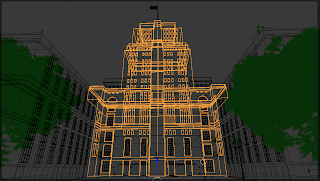Week 2 of the Architecture Academy stepped through creating an exterior view of a house from a groundplan.
Some early frustrations with Mr Price on the plans provided, there was no way to make the side view and the top views match up, and no front view provided at all, so it was necessary to fill in some gaps and imagine what the front looked like without a front elevation to go on.
With the modelling out of the way, the topic moved onto texturing, I learned quite a few tips and tricks for UV unwrapping and layering textures to get the right effect, even for the bits I did know, some useful guided practice.
Then adding foliage, straightforward.
Finally adding grass - what a nightmare. My trusty workstation, which is a couple of years old now, my fairly recently upgraded Nvidia 580 GPU rendered useless as it didn't have enough RAM to hold the scene, really stuggled to handle the particle systems.
There really needed to be around 250,000 x 20 child particles to make the grass look convincing. Max I could handle was 100,000 x 20.
After a lot of messing around, simplifying the scene wherever possible, loading lower res texture files, dialling back a few subsurf levels and bevel amounts, I managed to get a render going that would not crash my system. Then, tweaking was painful, two hours to see the result of any adjustment and a further hour each time to get back in balance where my system would not crash. Time to get really precise on the adjustments, it just took too long to be thrashing about in the dark.
I ended up making the ground texture look as much like moss as possible
with heavy "bump" applied, colour matching the ground with the grass, and
weighting the secondary clover particle system to the area immediately
infront of the camera as much as possible. Even with that, I needed to
add additional vignetting to the bottom of the image in post-processing
with a box mask to take the eye away from the close-up areas of lawn.
The final render took 4 hours to get 500 passes. Although it was a struggle, I am quite pleased with it.
Edit: I should know better by now. Every time I rush to post a result, and say I am pleased with it, I look at it next day and I'm no longer pleased with it.
At the very least, you should, time permitting, let your images rest and cast a fresh look on them before pressing the "send" button. {Bertrand Benoit}
Here is the better version:
Furniture and plants scaled down to 75%, re-did the grass and daisys, lowered the environmental lighting for stronger shadows, dropped the over-done bottom-half vingnette, desaturated the sunflowers, and rendered for another 4 hours.
I've kept the original below for comparison.




























